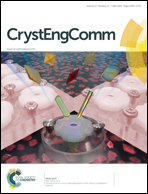Architectures varying from discrete molecular units to 2-dimensional coordination polymers and photoluminescence behavior of zinc and cadmium comprising an anionic zwitterion of rigid 4,5-dicarboxy-1,3-dimethyl-1H-imidazolium iodide†
Abstract
A rigid imidazolium dicarboxylate ligand, 4,5-dicarboxy-1,3-dimethyl-1H-imidazolium iodide (H2DDII), was synthesized and employed in the construction of metal complexes or coordination polymers (CPs) comprising an anionic zwitterion (DDI−), namely, [Zn(Cl)(H2O)2(DDI)]·(H2O) (2), {[Zn2(DDI)3(H2O)2]·I}n (3), [Zn2(DDI)2I]·2H2O (4), [Zn(DDI)2(H2O)3]·(H2O)2 (5) and [Cd(DDI)2]n (6). In addition, the ligand upon crystallization forms a zwitterion, [HDDI, (1)] by losing HI and shows both intra- and intermolecular H-bonding and an interesting intermolecular C![[double bond, length as m-dash]](https://www.rsc.org/images/entities/char_e001.gif) O⋯C short contact. The carboxylate unit of the ligand exhibits terminal monodentate and bidentate chelate modes of coordination. The stoichiometric ratio of metal to ligand, nature of base, type of metal salt and solvent conditions affected the architectures and dimensionality of 2–6 from zero dimensional monomers and dimers to 2D coordination polymers (CPs). Complex 2 forms a discrete molecular unit extended by supramolecular interactions to form 2D rectangular sheets. In 3, a crown shaped macrocycle results in a 2D herringbone CP and extends to a 3D supramolecular architecture on account of a coordination network containing trapped iodide as counter anions. Complex 4 forms a dimer with coordinated iodide ions and forms an infinite 1D ladder shaped supramolecular architecture. Complex 5 forms another discrete molecular unit different from 2, and extends to a 3D architecture through supramolecular interactions. Complex 6 forms a 2D CP with Cd(II) forming an interesting “fish scale pattern” and lacks any counter anion or solvent molecules. Additionally, the thermal stability of complexes 2–6 was analyzed by thermogravimetric analysis. In addition, the solid state photoluminescence properties of H2DDII and compounds 2–6 were investigated at room temperature.
O⋯C short contact. The carboxylate unit of the ligand exhibits terminal monodentate and bidentate chelate modes of coordination. The stoichiometric ratio of metal to ligand, nature of base, type of metal salt and solvent conditions affected the architectures and dimensionality of 2–6 from zero dimensional monomers and dimers to 2D coordination polymers (CPs). Complex 2 forms a discrete molecular unit extended by supramolecular interactions to form 2D rectangular sheets. In 3, a crown shaped macrocycle results in a 2D herringbone CP and extends to a 3D supramolecular architecture on account of a coordination network containing trapped iodide as counter anions. Complex 4 forms a dimer with coordinated iodide ions and forms an infinite 1D ladder shaped supramolecular architecture. Complex 5 forms another discrete molecular unit different from 2, and extends to a 3D architecture through supramolecular interactions. Complex 6 forms a 2D CP with Cd(II) forming an interesting “fish scale pattern” and lacks any counter anion or solvent molecules. Additionally, the thermal stability of complexes 2–6 was analyzed by thermogravimetric analysis. In addition, the solid state photoluminescence properties of H2DDII and compounds 2–6 were investigated at room temperature.


 Please wait while we load your content...
Please wait while we load your content...